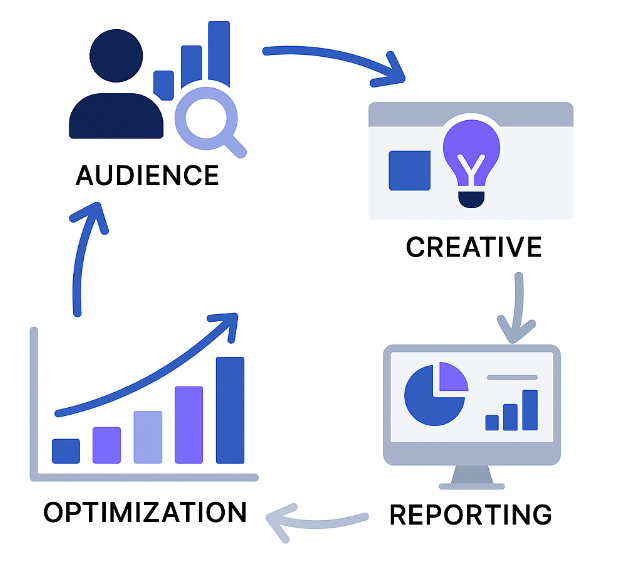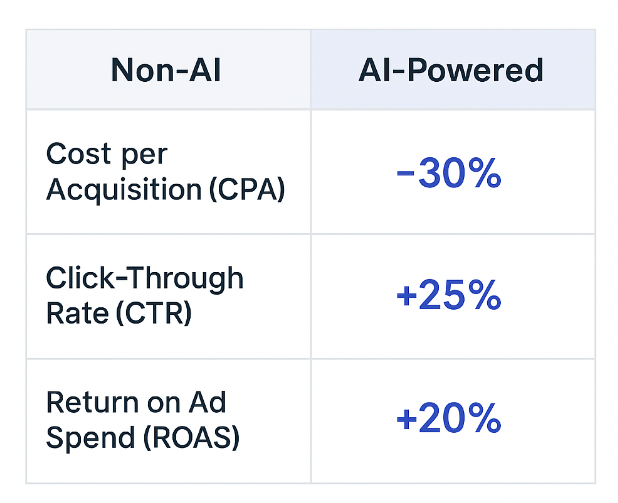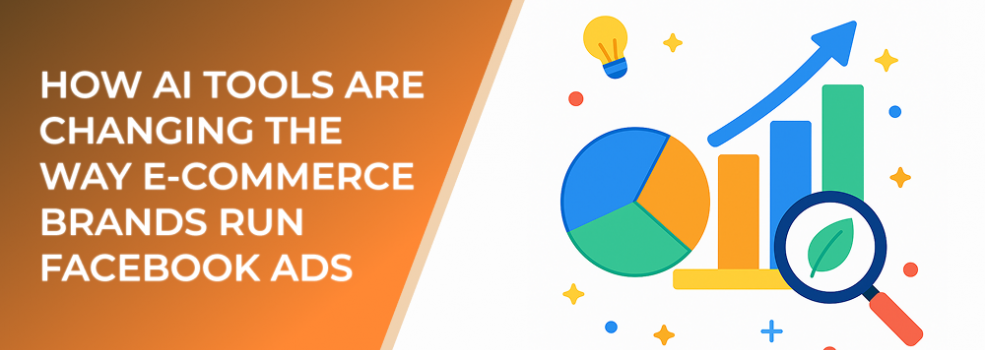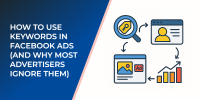Facebook’s advertising ecosystem has always relied on algorithms, but the integration of advanced AI tools has changed the game. Today, advertisers can automate targeting, personalize creative content, and analyze massive datasets faster than ever. According to Meta, over 80% of advertisers already use some form of automation or machine learning in their campaigns.
For e-commerce brands, AI is no longer optional—it’s a competitive advantage.
1. Smarter Targeting and Audience Discovery
AI tools can identify high-intent audiences that traditional demographic targeting might miss. Platforms like Meta Advantage+ and audience modeling tools automatically analyze user behavior, purchase patterns, and engagement signals to find lookalike audiences with higher conversion potential.

Overview of how AI tools power every stage of a Facebook ad campaign—from data to insights
For instance, an AI-driven campaign can track patterns among thousands of customer interactions and automatically shift budget toward users most likely to purchase. Brands using predictive targeting report up to 30% lower cost per acquisition (CPA) compared to manual targeting.
2. Automated Creative Generation and Testing
AI tools have made ad creative testing more efficient. Instead of manually designing and testing multiple ad variations, AI can generate hundreds of creative combinations—from headlines and descriptions to image and video formats.
Dynamic Creative Optimization (DCO) automatically tests different combinations in real time and prioritizes those with the highest engagement. According to Meta data, campaigns using AI-powered creative testing achieve 20–50% higher click-through rates (CTR) on average.
This approach saves both time and budget, while ensuring creatives stay relevant across audience segments.
3. Predictive Budget Allocation
AI doesn’t just improve performance—it optimizes spend. Machine learning models can forecast which campaigns, ad sets, or audiences will deliver the best return before spending begins.

Performance gains from using AI: lower acquisition cost, higher click-through rate, and improved ROAS
AI-based budget automation tools distribute resources dynamically across ad sets based on real-time results. For example, if one campaign is driving stronger conversions, AI automatically increases spend there. This predictive optimization can lead to up to 25% improvement in ROAS (Return on Ad Spend).
4. Personalized Ad Experiences
AI allows brands to deliver personalized ads to every individual viewer. Facebook’s algorithm analyzes user behavior, intent, and even contextual data (like device type or time of day) to tailor each ad impression.
E-commerce brands can now deliver highly relevant product recommendations using catalog-based AI ads. Personalized ads result in up to 2x higher engagement and 1.8x better conversion rates, making personalization one of the most effective ways to scale efficiently.
5. Enhanced Performance Tracking and Reporting
AI simplifies data analysis by identifying performance trends automatically. Instead of manual spreadsheet reviews, marketers can use AI dashboards that interpret data, flag anomalies, and generate actionable insights.
AI-driven analytics can detect underperforming audiences or creatives early and suggest changes instantly. This kind of automation allows brands to act faster and stay ahead of competitors.
6. Integrating AI With Human Insight
While AI handles optimization and prediction, human marketers remain essential for strategy, storytelling, and emotional appeal. The most successful e-commerce advertisers combine AI precision with human creativity.
Marketers should use AI as a decision-support tool, not a replacement for human expertise. This synergy ensures that campaigns remain authentic while maximizing performance.
7. The Future of AI-Driven Facebook Ads
AI will continue to evolve, with more predictive features, creative generation tools, and privacy-focused targeting models. Meta is already testing AI assistants that recommend ad structures, optimize copy, and automatically adjust bids in real time.
As privacy regulations tighten and data availability changes, AI will play an even more critical role in helping advertisers adapt efficiently without losing performance.
Related Articles from LeadEnforce
-
How to Analyze Campaign Data to Identify Growth Opportunities
-
Meta Ad Campaign Objectives Explained: How to Choose the Right One
Final Thoughts
AI has turned Facebook advertising from guesswork into science. For e-commerce brands, the ability to target smarter, test faster, and optimize spending automatically means greater efficiency and profitability. As tools continue to advance, the brands that embrace AI early will dominate the future of digital advertising.

